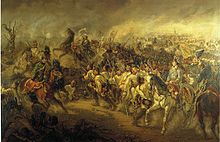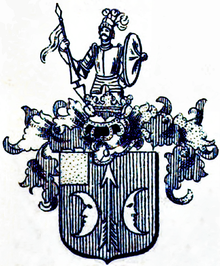Peter Duka from Kádár

Friedrich Peter Freiherr Duka von Kádár (* 1756 in Esseg ( Slavonia ), † December 29, 1822 in Vienna ) was an Aromanian k. k. Privy councilor , officer ( Feldzeugmeister ) and owner of the Hungarian Infantry Regiment No. 39, then State and Conference Council of the Emperor.
biography

He joined the 13th Wallachian-Illyrian Regiment in Caransebeş as a cadet in 1776 , but was transferred as a lieutenant to the general staff two years later due to his obvious skills , and in 1787 he was a captain .
Appointed major on December 1, 1789, he was transferred to the Coburg Army in the Austrian Netherlands in 1793 . After having explored the area extensively for three days before the Battle of Famars , he decided to lead the decisive attack from the main column in four divisions, each led by a reserve artillery battery. He was able to communicate the main objectives to the artillery director Lieutenant Colonel Karl Freiherr von Rouvroy and led the fourth division himself. After further significant deeds in the battles of Berlaimont and Maubeuge , he was rewarded on May 1, 1794 with the promotion to lieutenant colonel and on July 7, 1794 with the Knight's Cross of the Military Maria Theresa Order . In 1795, as General Wurmser's chief of staff , he planned the successful attack on Mannheim and accompanied it a year later - now a colonel (February 24, 1796) - to Italy , where he had designed the lost battle of Castiglione .
He was promoted to major general on May 31, 1798 and was assigned to Archduke Charles' military staff in Prague, only to join the general staff in Germany a year later. There he led Lieutenant Field Marshal Freiherr Staader von Adelsheim's left wing in the successful defense in the Battle of Stockach .
After he had become the fortress commander of Temesvar on May 5, 1800 , he was promoted to field marshal lieutenant on January 14, 1801 and from March of that year also entrusted by Archduke Karl with the post of chief of the quartermaster's staff for the armies in Germany and Italy ( until April 1805), with the order to begin an army reform; however, because of its conservative stance, it was not a good choice for this project. Nonetheless, on October 7, 1803, he became the owner of the Hungarian Infantry Regiment No. 39.
In 1805 Duka was the commanding general in the Banat. He held this office until his death. In 1808 the emperor awarded him the baron class with the title of Kádár for himself and his legitimate descendants.
On September 2, 1813, he rose to Feldzeugmeister and Adjutant Emperor Francis I on. In this capacity he was sent to Lusigny-sur-Barse to negotiate an armistice with Napoleon .
The emperor finally elevated the general to Vienna on April 22, 1815, to the bohemian baron class with incolat , on July 26, 1816 there to the Hungarian baron class and to the real secret council as well as state and conference council.
Awards
The general received numerous decorations, including:
- Knight's Cross of the Military Maria Theresa Order (1794)
- Grand Cross of the Austrian Leopold Order (1813)
- Army cross for 1813/14
- Grand Cross of the Royal Bavarian Max Joseph Order (1814)
- Grand Cross of the Ordre royal et militaire de Saint-Louis (1816)
- Royal Prussian Red Eagle Order 1st Class (1813)
- Imperial Russian Order of St. Anne 1st Class (1813)
- Alexander Nevsky Order (1813)
- Royal Neapolitan-Sicilian January Order (1819)
coat of arms
1802/1808: In red shields with a golden free quarter in the right ohereck, a pole-like, flicked arrow, the middle shaft accompanied on both sides by an outward-facing silver crescent moon. Treasure: Harnessed man growing, with an open helmet with ostrich feathers and girdled swords, in the raised right hand a tournament lance and flag, in the left hand holding an oval shield. The covers are red and silver on the right and red and gold on the left. The barons coat of arms still shows the barons crown. (Letter of nobility and coat of arms from King Franz I dd 1792 for Michael Duka; Freiherrnstand von King Franz I dd 1808 for Feldzeugmeister Peter von Duka)
family
In 1806 the baron bought the Wallachian community Kádáreste (Romanian: Cadăr) on Pogăniş in Timiş County , three miles south of Timiş Castle . The predicate Kádár in the nobility letter of 1815 probably refers to this. The 748 inhabitants were spread over 134 houses, were predominantly Romanian- speaking and of the Romanian Orthodox denomination. His sons Stephan, Emil, Eugen and Peter inherited the village after his death. His granddaughter Anastasia (born October 31, 1828 in Belatincz , Zala County , Hungary ; † March 27, 1907 in Graz ) married Count Vincenz von Logothetti (1824–1886).
literature
- Jaromir Hirtenfeld : The military Maria Theresa order and its members. Volume 1, KK Hof- und Staatsdruckerei, Vienna 1857
- Constantin von Wurzbach : Duka, Peter Freiherr von . In: Biographisches Lexikon des Kaiserthums Oesterreich . 3rd part. Typogr.-literar.-artist publishing house. Establishment (L. C. Zamarski, C. Dittmarsch & Comp.), Vienna 1858, p. 389 f. ( Digitized version ).
- Wilhelm Edler von Janko : Duka, Peter Freiherr von . In: Allgemeine Deutsche Biographie (ADB). Volume 5, Duncker & Humblot, Leipzig 1877, p. 455.
- Duka von Kadar, Friedrich (Peter) Frh .. In: Austrian Biographical Lexicon 1815-1950 (ÖBL). Volume 1, Verlag der Österreichischen Akademie der Wissenschaften, Vienna 1957, p. 203.
- David Hollins: Austrian Commanders of the Napoleonic Wars 1792-1815 . Osprey Publishing, Oxford 2004, ISBN 1-84176-664-X .
- Antonio Schmidt-Brentano: Imperial and Imperial and Royal Generals (1618-1815). Austrian State Archives / A. Schmidt-Brentano 2006.
- Tötösy de Zepetnek, Steven, ed. Nobilitashungariae: List of Historical Names of the Hungarian Nobility / A magyar történelmi nemesség családneveinek listája . West Lafayette: Purdue University Press, 2010-. http://docs.lib.purdue.edu/clcweblibrary/nobilitashungariae .
Individual evidence
- ^ Austrian East and Southeast Europe Institute, Working Group East: "Österreichische Osthefte", Volume 36, Austrian East and Southeast Europe Institute, Vienna 1994, p. 452
- ↑ Archived copy ( Memento of the original dated December 3, 2013 in the Internet Archive ) Info: The archive link was inserted automatically and has not yet been checked. Please check the original and archive link according to the instructions and then remove this notice.
- ↑ http://www.austro-hungarian-army.co.uk/mmto1.htm
- ↑ http://www.napoleon-series.org/military/organization/Austria/infantry/c_austrianinf4.html
- ↑ Hubert Zeinar : "History of the Austrian General Staff," Böhlau Verlag GmbH and Co. KG, Vienna - Cologne - Weimar. 2006, p. 832
- ↑ Hubert Zeinar: “History of the Austrian General Staff”, Böhlau Verlag GmbH and Co. KG, Vienna - Cologne - Weimar 2006, p. 272
- ^ Antonio Schmidt-Brentano: Imperial and Imperial Generals (1618-1815), Austrian State Archives / A. Schmidt-Brentano 2006, p. 27
- ^ David Hollins: "Austrian Commanders of the Napoleonic Wars 1792-1815", Osprey Publishing, Oxford, 2004, p. 60
- ↑ Duka von Kadar, Friedrich (Peter) Frh. In: Austrian Biographical Lexicon 1815–1950 (ÖBL). Volume 1, Verlag der Österreichischen Akademie der Wissenschaften, Vienna 1957, p. 203.
- ↑ http://www.coresno.com/index.php/standeserhoehungen/181-rekem/4561-rekem
- ↑ Stephan Tötösy de Zepetnek (ed.): Nobilitas Hungariae - A magyar történelmi nemesség családneveinek listája . Purdue University Press, West Lafayette 2010
- ^ Johann Siebmacher (original): The nobility of Croatia and Slavonia (= J. Siebmacher's great book of arms, volume 35). Verlag Bauer & Raspe, Nuremberg 1986, p. 42
- ↑ napoleon-series.org
- ↑ http://www.banaterra.eu/magyar/L/lexikon/k_lexikon/k_lexikon.htm
| personal data | |
|---|---|
| SURNAME | Duka from Kádár, Peter |
| ALTERNATIVE NAMES | Duka von Kádár, Peter Freiherr (full name) |
| BRIEF DESCRIPTION | Austrian officer (Feldzeugmeister) |
| DATE OF BIRTH | 1756 |
| PLACE OF BIRTH | Esseg |
| DATE OF DEATH | December 29, 1822 |
| Place of death | Vienna |


